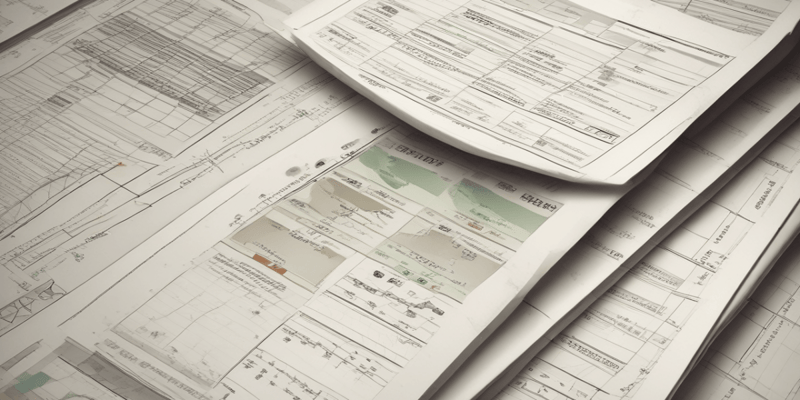Podcast
Questions and Answers
Qu'est-ce que l'Emplois stables dans le bilan fonctionnel?
Qu'est-ce que l'Emplois stables dans le bilan fonctionnel?
Quelle catégorie de l'Actif circulant inclut les stocks et les comptes clients?
Quelle catégorie de l'Actif circulant inclut les stocks et les comptes clients?
Quelle colonne du bilan fonctionnel correspond aux passifs et à l'équité?
Quelle colonne du bilan fonctionnel correspond aux passifs et à l'équité?
Qu'est-ce que l'Actif circulant hors exploitation inclut dans le bilan fonctionnel?
Qu'est-ce que l'Actif circulant hors exploitation inclut dans le bilan fonctionnel?
Signup and view all the answers
Que représente la colonne Ressources dans le bilan fonctionnel?
Que représente la colonne Ressources dans le bilan fonctionnel?
Signup and view all the answers
Quel outil d'analyse permet d'évaluer si les ressources stables sont suffisantes pour couvrir les emplois stables d'une entreprise?
Quel outil d'analyse permet d'évaluer si les ressources stables sont suffisantes pour couvrir les emplois stables d'une entreprise?
Signup and view all the answers
Que signifie un Besoin en Fonds de Roulement (BFR) positif pour une entreprise?
Que signifie un Besoin en Fonds de Roulement (BFR) positif pour une entreprise?
Signup and view all the answers
Quelle composante du Passif circulant est incluse dans le Passif circulant hors exploitation?
Quelle composante du Passif circulant est incluse dans le Passif circulant hors exploitation?
Signup and view all the answers
Comment peut-on interpréter une Trésorerie nette négative pour une entreprise?
Comment peut-on interpréter une Trésorerie nette négative pour une entreprise?
Signup and view all the answers
Que révèle un Fonds de Roulement Net Global (FRNG) négatif sur la situation financière d'une entreprise?
Que révèle un Fonds de Roulement Net Global (FRNG) négatif sur la situation financière d'une entreprise?
Signup and view all the answers
Study Notes
Bilan Fonctionnel: Understanding the Functional Balance Sheet
The functional balance sheet, or bilan fonctionnel, is a financial document that provides a more comprehensive view of an enterprise's financial structure compared to the traditional balance sheet. It is a reorganized version of the balance sheet, which analyzes the company's assets and liabilities in a more detailed manner to assess the equilibrium of the financial structure.
Key Features of the Bilan Fonctionnel
The bilan fonctionnel is structured into two main columns:
- À gauche: Emplois, which correspond to the assets in the balance sheet, and only their total value is retained.
- À droite: Ressources, which correspond to the liabilities and equity in the balance sheet.
The emplois are grouped into three categories:
- Emplois stables: These are long-term expenses that commit the enterprise, such as immobilizations brutes.
- Actif circulant d'exploitation: Includes stocks, accounts receivable, and other current assets.
- Actif circulant hors exploitation: Contains accounts receivable and other current assets not related to the main business activity.
- Trésorerie active: Includes cash, short-term investments, and other liquid assets.
The ressources are classified into two categories:
- Trésorerie passive: Represents the current liabilities of the enterprise.
- Passif circulant d'exploitation: Includes accounts payable, accrued expenses, and other current liabilities related to the main business activity.
- Passif circulant hors exploitation: Contains accrued expenses and other current liabilities unrelated to the main business activity.
Analyzing the Bilan Fonctionnel
The bilan fonctionnel is analyzed using three tools:
- Fonds de Roulement Net Global (FRNG): Assesses the enterprise's financing of its long-term commitments. A positive FRNG means that the ressources stables are sufficient to cover the emplois stables, while a negative FRNG suggests that the ressources stables are insufficient.
- Besoin en Fonds de Roulement (BFR): Determines the amount of funds the enterprise needs to finance its operating activities. A positive BFR indicates that the enterprise has sufficient current assets to cover current liabilities, while a negative BFR suggests that the current assets are insufficient.
- Trésorerie nette: Represents the balance between the trésorerie passive and the trésorerie active. A positive trésorerie nette indicates that the enterprise has more liquid assets than liabilities, while a negative trésorerie nette suggests that the liabilities exceed the liquid assets.
By analyzing the bilan fonctionnel, an enterprise can gain insights into its financial structure, evaluate its investment and finance policies, and identify potential weaknesses that can be addressed through strategic measures.
Studying That Suits You
Use AI to generate personalized quizzes and flashcards to suit your learning preferences.
Description
Explore the bilan fonctionnel, a financial document that offers a comprehensive view of an enterprise's financial structure. Learn about its key features, including the categorization of assets and liabilities, and understand how to analyze it using tools like FRNG, BFR, and trésorerie nette.




